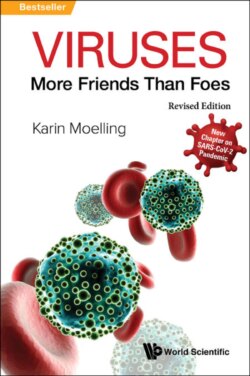Читать книгу Viruses: More Friends Than Foes (Revised Edition) - Karin Moelling - Страница 38
На сайте Литреса книга снята с продажи.
No vaccine against HIV?
ОглавлениеWhat is the result after 30 years of vaccine development? There is no vaccine and after so many wrong promises nobody dares to make any more predictions. When HIV was discovered, molecular biologists assumed that a vaccine could be produced immediately. The model was the hepatitis B virus (HBV), where a surface molecule induces antibodies that neutralize the virus, counteract its infectivity and prevent its replication. By analogy to HBV, the envelope sequence of HIV was selected as the basis for vaccine development, and the sequence was known within a few months. The DNA of the surface protein of HBV was then used to produce a protein in yeast or in bacteria by recombinant DNA technology — the first successful vaccine ever to be produced by this novel technology. However, this did not work out for HIV, even though it has some similarities with the hepatitis virus, HBV. The reason is that HBV is genetically more stable, and it carries an almost complete double-stranded DNA inside the virus particle, which does not change easily in contrast to the single-stranded RNA genome of HIV, which is so variable that all efforts to “capture” it have so far failed. The prediction of virologists was thus far off the mark that all the people involved are still ashamed of it, since the differences between hepatitis B virus, HBV and HIV were even then known to all researchers. The vaccines against the surface protein were at best capable of neutralizing the virus used in the test-tube, but not the viruses in real life, which do not consist of one species but of many different ones, the quasispecies, and furthermore can rapidly change.
An unintended “vaccination” took place in Australia when patients with a blood-clotting deficiency received supplementation with a blood product called Factor VIII. However, the product they received was contaminated with a virus that was defective and lacked an accessory gene of HIV, the pathogenicity (originally “negative”) factor Nef. This was a slowly replicating virus and would have been an ideal vaccine, as known from previous vaccines, e.g. the vaccine against poliomyelitis, an attenuated (slowly replicating) virus. That is one of the best designs for a vaccine. However, after a dozen years some recipients of the contaminated Factor VIII fell ill: the virus had reverted to a faster-replicating virus, replenishing the defective gene and causing the disease — to the great surprise of the virologists.
The surface protein has been analyzed down to its last possible detail, but so far without success. The virus needs this surface molecule to find its host cell. Therefore, surface molecules are still in the focus of attention. Today a new approach is being taken, exploiting the antibodies of long-term survivors, termed long-term non-progressors (LTNP) or elite controllers (EC). Out of the whole antibody reservoir of such an infected but resistant person, the antibodies that bind to the surface of HIV and neutralize it, to make it non-infectious, are selected in the laboratory. 200,000 antibodies were screened in a tour de force to select a few candidates, which are now under development for producing a novel vaccine.
An early large scale clinical trial, RV144, was performed in Thailand with 16,000 volunteers, and evaluated more than once, with always better interpretations, depending on the statistics between 2009 and 2015. The vaccine is a prime-boost combination of a canarypox virus vector (ALVAC) and gp120 viral surface proteins (from clades B and AE, as monomers not the trimers, it was not known initially that the coat protein naturally trimerizes, so this vaccine was not optimal). It reduced the risk of infection by 31%. The Bill and Melinda Gates Foundation is sponsoring a variation of this vaccine in Africa with 5400 volunteers (clade C) and predicts — or hopes for — success by 2030.
New technologies identify “broadly neutralizing antibodies” (bnAbs) with a new strategy. If one vaccine fails, maybe several of them will succeed — by sequential immunizations, though. The immune response could then be guided stepwise to develop special classes of antibodies to fight HIV — several sequential vaccines shooting at a moving target? Difficult. Adeno-associated virus (AAV) expresses the bnAbs in an ongoing clinical trial in the U.K. A vaccine “Ad-Env” is tested by Dan H. Barouch at Harvard with an adenovirus modified to express several HIV proteins (Gag, Pol, and Env) and a subsequent boost with the viral surface Env protein alone.
Then there is a “cheating approach” on the way. Instead of using the real viral surface protein one synthesizes a similar one as antigen, more immunogenic than the native viral surface Env, in the hope that antibodies will also recognize the native one better. This approach is known in animal studies (we also used it successfully), it may work but it is new for HIV. Now a “replicating” vaccine virus is going to be tested: remember, replicating viruses are the most efficient ones as vaccines — if they do not cause diseases. In this case the virus is a modified herpes virus CMV, so no intact HIV can arise from the vaccine again. Let us hope and wait — 15 years? 30 years?
